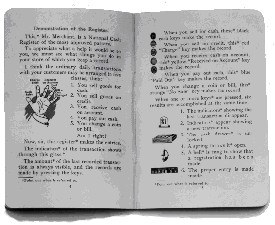
Webinar: Tuesday, April 29th @1pm
Winning at Retention-
Proven Strategies to Reduce Cancellations, Winback Customers & Drive Lifetime Value
Sign up Now
Early on, Patterson was concerned about the quality of sales, and so –in true Patterson style – he decided to learn firsthand what was happening in the field. In a period of 51 days, he visited sales offices in 50 towns and cities. What he found appalled him. “One half of our salesmen are so ignorant of their product that they will actually prevent a man from buying, even though he wanted a cash register,” he said.
Returning to Dayton, he proceeded to gather the sales talks of the NCR’s most successful salespeople, writing up every known selling point related to the cash register. The document became one of the first canned sales presentations – the NCR Primer.
Patterson made it a requirement that all salesmen learn the 400-word document by heart. Many of the older reps balked. When Patterson discovered their resistance, he implemented tests; those who failed or refused to memorize the primer were fired. The remainder saw their sales soar. The reason: For the first time ever, they had a consistent presentation that covered all the important features and benefits of their products.

The primer divided a sale into four steps: approach, proposition, demonstration, and close. In the approach, salespeople made no mention of the cash register. Instead, they explained that they wanted to help the business owner find ways to increase profit. In essence, the salesperson assumed the role of a consultant.
In the proposition, the salesperson described the register for the first time and explained how it would prevent theft and give an accurate account of the day’s receipts. The goal of this stage was to schedule a demonstration of the machine in a nearby hotel where the salesperson had set up a display.
The primer was soon followed by the Book of Arguments, which later developed into the NCR Manual, a compendium of answers to every kind of question a prospect might ask. The manual was the first ever systematic approach to handling customer objections. It also discussed topics such as introductions, first interviews, critical sales situations, and closing arguments. Like the primer, it was drawn from the minds of the best NCR salesmen and compiled, again, with the goal of establishing consistency.
Many salespeople today would benefit from the wisdom of the NCR Manual. Always, it had one objective: to help the prospect understand the value of the solution, not merely to batter and cajole the prospect into placing an order or to win in a series of arguments – still major stumbling blocks today.
Providing the primer and manual was one thing; assuring that salespeople would commit to memory the techniques outlined therein was another. Even with these marvelous tools at their disposal, many salesmen balked at learning. It must have seemed to Patterson that, time and again, he had to drag mule-headed reps to a trough that brimmed with milk and honey.
While attending the 1893 World’s Fair in Chicago, Patterson stopped off at the NCR display booths and quizzed the young salespeople. To his astonishment, hardly any of them knew what they were talking about, despite all the sweat he’d devoted to creating the primer and manual.
Patterson promptly hauled the reps off to a hotel room for a training session. This class was neither more nor less than a review of the most basic Q’s and A’s about NCR products – material drawn straight from the primer and manual. Patterson was so delighted with the results of the impromptu sessions that he decided to inaugurate training schools for all of his salespeople.
The first sales-training school was opened in Dayton the following spring. Though based on the timeworn teacher/pupil format, the classes were as exciting as Patterson himself – a man who once deliberately shattered a water pitcher on a podium to get the audience’s attention.

Before every sales meeting, Patterson wrote “Think!” on a flip chart. He also had a plaque on his desk and created this placard (22×14 inches) to alert visitors that thinking was a prerequisite before speaking with Patterson. His sales manager, Thomas Watson Jr., copied the idea, and when he started IBM, he placed a sign on his desk, sending out the same message to his team. Years later, IBM created the ThinkPad laptop. (Later, Apple dropped the word “Think” and placed an “i” before “Pad.”

With illustrations, demonstrations, and a good bit of Pattersonian drama tossed in, NCR sales-training instructors coached salespeople on the very modern concept of thinking in terms of the prospect’s needs, rather than in terms of the product. These training sessions were really classes in the art of communication, understanding the prospects, and making sure that they understood the sales message.
This was a hot topic with Patterson. He was often quoted as saying that fully one half of all lost sales could be attributed to the salesman’s failure to communicate. The erring sales rep might fail to clarify a point, talk indistinctly, make confusing claims, or in some way fail to relay his own mental picture to the prospect.
Patterson rectified the problem of poor communication by teaching salespeople to listen to prospects. They were taught to modify set sales presentations depending on the type of customer and sales resistance shown. Patterson even hired elocutionists to teach sales agents to speak like masters of the stage.
A firm believer in “teaching through the eye” using charts, graphs, drawings, or any other visual aid to get a point across to his sales force, Patterson told salespeople to use the same technique with prospects. Salespeople were schooled in how to illustrate a presentation on a scratch pad while talking about cash registers. Later, outline charts were printed on the pads, which salespeople would complete as they developed their presentations.
The salespeople turned out by the NCR training school were a well-honed lot. Estimates made at the time show that this training was directly responsible for doubling business in the first year.
See Part III tomorrow!
Get the latest sales leadership insight, strategies, and best practices delivered weekly to your inbox.
Sign up NOW →